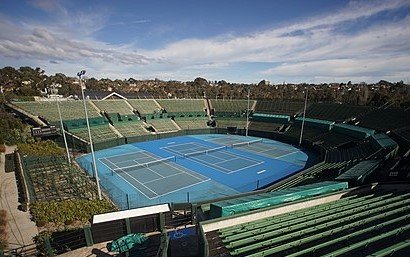Tennis currently finds itself in a slightly odd place. On the men’s side, we’re transitioning from the Federer/Nadal/Djokovic era of domination, into what many are predicting to be a Sinner/Alcaraz era of domination. Only time will tell, but right now, there’s a perceived dip in quality of matches, in quality of marketable players to move the game forward, and the quality of the overall tennis product.
How do we improve tennis?
We’ve also just come off a US Open which, if we’re being honest, failed to live up to the expectations of a major, as far as epic matches are concerned. We have a Davis Cup format that is unrecognizable, and more and more ‘exhibition events’ taking place. All the while, players are screaming out for more money, and a shorter season.
Kamil Patel is a former Mauritian ATP player, Davis Cup and Fed Cup captain, as well as the president of the Mauritian Tennis Federation for 14 years. Having recently stepped down from this role, I was fortunate enough to chat with Patel, and get his insights on where he thinks the game is going, and what, if anything, we can do about it.

Kamil grew up in Ethiopia, where his parents were working for the UN. This is where he learned to play tennis in the early 80’s. He showed some promise, began winning tournaments, was offered scholarships, and ended up venturing to France and America. He turned pro while in America, and played on the ITF tour for the majority of his career. Due to personal circumstances, at 23, he had to stop playing tennis to move back to Mauritius. But the passion for the sport never died out, and he soon became the Davis Cup captain, Fed Cup captain, and president of the Mauritian tennis federation.
It’s fair to say he isn’t enamoured with the path tennis is going down over recent decades…
Kamil coined the concept of “tennis suicide,” that refers to a gradual decline in the quality and integrity of tennis over the past 25 years, due to various rule changes and scheduling decisions. Kamil argues that the erosion stems from shortening match formats, such as reducing finals from best-of-five to best-of-three sets, which has diminished the potential for emotionally charged, epic matches that captivate audiences. He also criticizes the decline of doubles, the changes to the Davis Cup, and the removal of advantage sets in Grand Slams, all of which, he believes, undermine the sport’s core appeal. Patel emphasizes that these shifts, driven by player demands for fewer matches and better pay, are detrimental to the game’s long-term health and fan engagement, leading to what he calls “tennis suicide.”
“There’s a list of things that I think that have been wrong, but basically in the last 25 years, there’s been a slow erosion of the quality of the content that tennis produces, and people don’t realize it because it’s very gradual. It’s one decision every 3 or 4 years, but it slowly chips away. I call it ‘tennis suicide’ because we’re doing it to ourselves.
The players are constantly petitioning for less play for more pay. That’s the constant that’s been going on for 20 years.
I’ve been thinking about tennis for 25 years. In 2003-2004, I organised an ATP Challenger in Mauritius. The main idea was, how do you bring fans to the stadium? How do you bring them in front of their TVs, and what’s the origin of it all?
We say spectators want to see big names, but how do the big names become big names? The essence of it all is in epic matches. People want to see two heroes battling it out to the death. One winner, one loser, in this great format of tennis. It works. People want to see those epic matches charged with emotions. That’s the main product that tennis sells, and that’s the most profitable product. Right now, it’s only the four men’s Grand Slams that offer it, and if you take that away, men’s tennis will go into slow decline, and end up probably like doubles is now. We’ll carry on shortening the format, saying people don’t have any attention span.”
Doubles Specialists Don’t Help the Doubles Brand
Speaking of doubles, Patel believes the decisions around doubles, has chipped away at the fabric of tennis, and is a massive part of ‘tennis suicide’. Patel views the sidelining of doubles as a signal of a larger trend: the prioritization of players convenience and commercial considerations over the fan’s love of the game. Just as doubles is now seen as less important and less economically viable, he fears that singles tennis will face a similar fate if the focus remains on shortening matches and reducing the physical demands on players. This shift, Patel argues, is gradually undermining the essence of tennis, where epic, grueling battles used to define the sport and captivate fans. Doubles, for Kamil, is not just a casualty but a warning of where the sport is headed.
“It started with doubles, with a decision of creating a best of two format, which doesn’t help. Doubles hasn’t become better from that decision. Allowing doubles specialists to play doubles has also, unfortunately, not helped.
I was also a doubles specialist at one point, but it doesn’t help tennis. It doesn’t bring the fans to the courts, and it doesn’t produce any epic matches. The singles players often withdraw from doubles, which they say is because they need to protect their health and well-being. But the reality is, I mean, I saw Kafelnikov win two Grand Slams in singles and doubles, including taking both titles at Roland Garros in 1996.
That argument of fitness, doesn’t hold at all, especially not in the current format.”
Where doubles left a massive hole, has no doubt been Davis Cup, and Patel is absolute in his viewpoint on this.
“Of course, the last blow to doubles was the death of Davis Cup. When Davis Cup disappeared, doubles had no more importance to anyone.
Before that, the main Saturday doubles match was important to every single federation. They needed to produce doubles players that could win that best of 5 doubles on the Saturday. It doesn’t exist anymore, so there’s no use for tennis federations to produce doubles players.
That whole need is just finished. Doubles is probably going to end up being cancelled, because nobody understands why you would have it in a tournament. It doesn’t make economic sense. For the fans, it’s an ‘also’ thing at tournaments. There was another blow to doubles this year…Wimbledon doesn’t do best of 5 sets in doubles anymore.
I think that’s major, because it does actually produce great matches, epics with high emotion, not necessarily for TV, but at least for the people in the stadium. And you’ve got 10, 15,000 people enjoying that. Sadly, that’s also finished.”
The transition to a best-of-three format in doubles, which started at Roland Garros in 1991, followed by the Australian Open in 2002 and the US Open in 1992, has not led to the anticipated boost in fan engagement or attendance. The longer best-of-five set format consistently produced high-intensity, epic matches that thrilled live audiences, with 10,000 to 15,000 people in the stadiums enjoying the drama and endurance of these contests. In recent Wimbledon tournaments, six out of the last ten best-of-five doubles finals went the distance, showcasing some of the most exciting tennis of the event. These matches, like the 2019 Wimbledon final between Cabal/Farah and Mahut/Roger-Vasselin, offered unforgettable moments of tension and emotion. Despite this, the shift to shorter formats persists, even though modern doubles players are specialists without singles commitments. There is no practical reason to reduce the format, as these players are not overburdened by schedules, and the shorter format detracts from the potential for gripping, crowd-pleasing encounters.
A Shift Back to Longer Matches is Needed
Patel doesn’t just advocate for best of 5 sets at the major events though. He would like to see the ATP Masters events move back to the format for the final. In 2008, the ATP Masters finals were reduced from best of 5 sets, to best of 3 sets, and that’s one of the decisions Kamil believes has eroded the quality of tennis.
On top of this, and in the shadow of the Paris Games, the Olympics should also revert to the longer match style, as a way to create more epics, and stand apart from the general tour.
“If you remember, the Masters 1000s used to play best-of-five finals. There were also quite a lot of ATP tournaments that had best-of-five formats for their finals, such as Gstaad (up to 2006), Bastad (up to 1974), Antwerp (up to 2006), and Stuttgart (up to 2006) to name a few.
You also had best-of-5 in the Masters, and best-of-5 for the Olympics. The Olympics in 1988 and 1992 was best-of-five from the first round. People tend to forget that. The Olympics should be best-of-5. The players didn’t want to play best-of-5, they said they’d rather play best-of-3. Now what happens is that the Masters 1000s, and the end of year finals do not produce epic matches anymore. I’m comparing the matches that we’re getting now in the finals of Masters 1000, to the famous Safin v Philippoussis at Paris, Bercy in 2000. If you watch it on YouTube now, I mean, these guys will still be winning today!
Looking back 10 to 15 years ago, there were key moments that highlighted the endurance and resilience of top players. For instance, after Roger Federer won Wimbledon in 2004, he played the very next week in Gstaad on clay at altitude. Remarkably, he won the tournament, defeating Jiri Novak in a best-of-five set final. This shows that fitness is not the issue. In fact, women, who typically play best-of-three, experience more injuries than men who regularly compete in best-of-five matches. Health concerns are therefore not the primary reason for shortening match formats. The real issue lies in the ATP Tour’s decision to move away from best-of-five set finals, which has stripped the game of its epic, high-stakes battles. Consider the contrast between the thrilling 2006 Monte Carlo final between Nadal and Federer and the far less gripping 6-3, 6-3 Tsitsipas vs. Rublev final. It’s hard to understand why broadcasters and spectators, would pay for such anticlimactic encounters. The abandonment of best-of-five set finals is a key factor contributing to what can only be described as tennis suicide.
It does beg the question, that if Masters finals were best of 5 sets, would that help or hinder the top players in the world? Would it increase fan engagement? Could a more demanding schedule create greater opportunities for up-and-coming players, thereby facilitating smoother generational transitions in the sport? It could expose more players to the best of 5 set format, giving them a slight edge when the major events come around. Or might it possibly just give the best players who consistently make the finals of Masters, a bigger advantage in their conditioning, thereby expanding the gap at the top?
Davis Cup change is ‘Crazy’
But Patel isn’t finished there. Having been a Davis Cup player and captain, it’s clear he’s not a fan of the new Davis Cup format. He’s also not alone there. Since the change in 2019, when the competition became more like a World Cup, with many ‘home and away’ ties going by the wayside, support for the event has been mixed at best. Patel holds no punches when criticizing the change from 120 years of history.
“Davis Cup was a great stepping stone for a player, let’s say, ranked 50, 60 or 70 in the world, to be able to play in front of his home crowd, make a name for himself in his own country, get sponsorship, get financing, which would then enable him maybe to grow into the next level. One of the examples is Rafael Nadal. His first trophy was a Davis Cup in 2004, that’s how he first burst onto the scene.
So cancellation of Davis Cup is really bad, especially for players wanting to make a name for themselves locally….that’s the chance for them to bond with their fans. Davis Cup has now been replaced by the Laver Cup, by UTS, by the Saudi exhibition. That’s quite hypocritical from the players to lobby for cancelling a Davis Cup, in order to free up weekends so they can play exhibitions.
‘The Big Four’ (Federer, Nadal, Murray, Djokovic), each wanted to win Davis Cup once, and then it could be cancelled. So, they all won the Davis Cup once, and then Davis Cup was cancelled. Crazy.”
Following on from the earlier point about playing 5 set epic matches, Patel is also a huge advocate of the advantage 5th set in majors. In 2016, the Davis Cup opted for a final set tie-breaker, before the Australian Open and Wimbledon followed suit in 2019, and the French Open fell into line in 2022. The US Open hadn’t been playing ‘advantage’ sets since 1970.
The big match that moved the needle on this, was quite clearly the famous John Isner/Nicholas Mahut clash at Wimbledon in 2010. After a 70-68 final set, with a match spanning 3 days, the breaking point had come.
Kamil agrees that introducing a tiebreak in the fifth set is practical for managing the length of matches, but it’s undeniable that the matches we all cherish in our collective memory are the battles that went beyond 6-all in the deciding set. Some of the greatest tennis battles in history featured advantage sets in the fifth, where the drama and tension built with every game, creating unforgettable moments. While the US Open was the first to implement a fifth-set tiebreak, Kamil finds it perplexing why, given the passion of American fans for emotionally charged, epic encounters, the organizers chose to deprive them of the pleasure that only a drawn-out, advantage-set battle can provide.
“I think that Grand Slams should never have cancelled the advantage set in the fifth (and third for women) that gave rise to incredible matches. I mean, you think of those Nadal v Federer finals or the Roddick v Federer final that went on, and created these incredible epics. That’s what you want to see. You want to see how the guys still have the fortitude to perform at 16 all in the third, or 20 all in the fifth, and who’s strong enough to be able to break the deadlock. That’s what people want to see.
That tiebreaker is a bit of anti-climax in the Grand Slams. It doesn’t matter so much on the ATP Tour, but in the Grand Slams it’s bad. The other point is that in the Masters 1000s, especially now it’s a 12-day event, the third set should be a long set. They should scrap the tiebreaker in the third set because with the 12 days they should make it a bit harder for the players. It can’t be easier than 12 days. I mean they play six matches in 12 days!”
No More ‘Tactical Breaks’
Having a day off between matches is one thing, but another aspect of modern tennis that Patel strongly disagrees with is the increasing use of toilet breaks at the end of sets—a practice that has gradually taken hold over the past decade. Patel believes these “tactical breaks,” where a player walks off court for 10-12 minutes to shower and change, disrupts the flow of the match and undermines the spirit of the game. “It’s a disgrace,” he says, “and completely against the values of tennis.” He argues that such breaks can significantly alter the outcome of matches, even suggesting that some Grand Slam results would have been different without them. The fact that tennis authorities have accepted this tactic, according to Patel, is a clear indication that the sport is headed in the wrong direction.
For him, it’s yet another powerful symbol of what he calls “tennis suicide.”
Read more of our exclusive feature articles here.
Follow Kamil Patel on X: @kamiltpatel
Follow The Tennis Site on X and Facebook: @thetennissite
Follow Todd Scoullar on X: @toddscoullar

